
As my most recent sandwich survey shows, after seeing some much-needed price relief in 2024, the average sandwich price is heading modestly higher again.
If you’re like most people, it’s been hard not to notice the increase in your monthly grocery bill over the past four years. After a huge run-up in prices for everything from gasoline to food – and despite the latest consumer price index showing that inflation in 2025 is currently running at an annual clip of “just” 3% – more grocery shoppers than ever can be seen visibly wincing when the final total flashes at the checkout counter.
Meanwhile, the estimated cost of a school lunch this year is $3.50. For a family with two kids, that amounts to $1260 during the course of a 180-day school year.
Oh, sure; $3.50 for lunch may sound like a great deal, but the truth is, despite food inflation and those ever-rising grocery bills, people who choose to brown-bag a sandwich, piece of fruit, and carrot sticks or a serving of chips, are always going to spend less than the folks who buy their lunch at a restaurant, school cafeteria or fast-food joint.
On the other hand, not all sandwiches are created equally, as celebrity chef Martin Blunos demonstrated a few years ago with his decadent $184 cheese sarnie. The good news is, while food prices are climbing faster than ever, the results of my 16th annual brown bag sandwich price survey show that most folks will spend far less than that in 2023.
How I Conduct the Sandwich Survey
As usual, I visited my local grocery store and recorded the per-serving costs of various ingredients for ten of the most common brown bag sandwiches: peanut butter & jelly (PB&J); bologna; tuna; ham & Swiss; roast beef & cheddar; egg salad; salami; American cheese; turkey; and bacon, lettuce & tomato (BLT).
For consistency, I only selected items with the cheapest per unit costs, regardless of brand. And to keep it simple, I also assume that all sandwiches are with wheat bread.
Sandwich Survey Ingredients Data
Here are the results of this year’s price survey. The survey date is July 27th, 2025. The first graphic shows the sandwich serving sizes and per-serving costs for each ingredient. It also includes the percentage increase or decrease in the per-serving price of each item from last year’s survey:
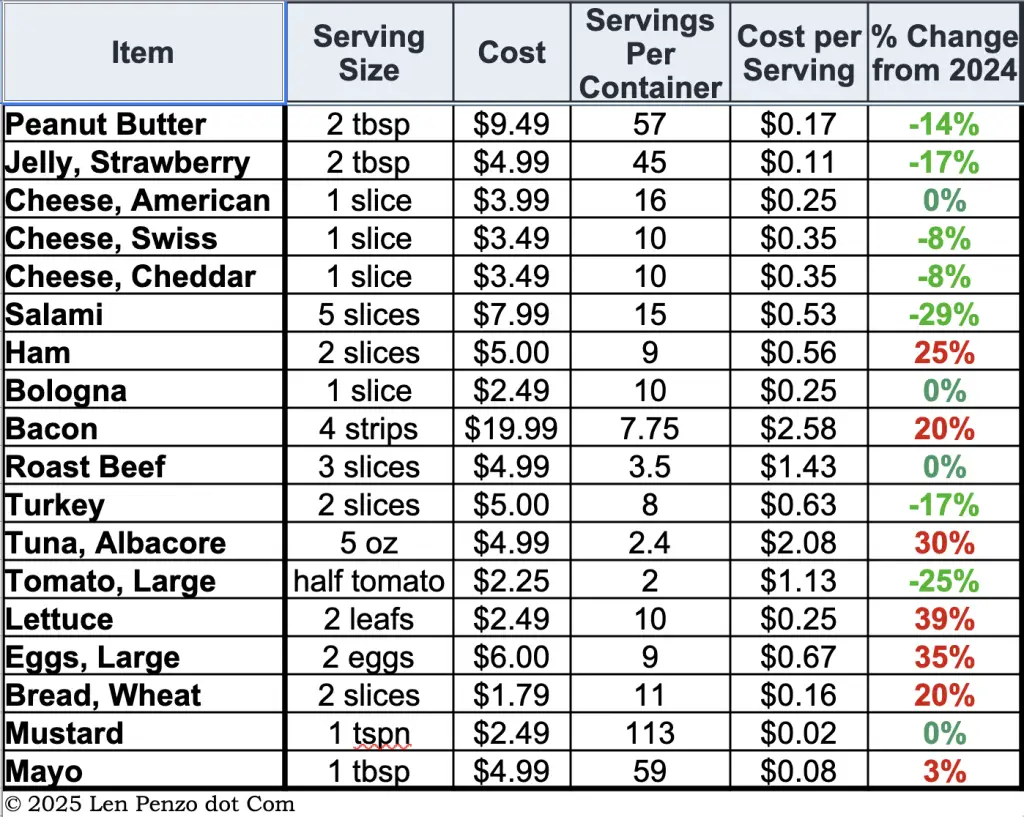
With that data in hand, and using my handy spreadsheet, it’s no effort at all to determine the most economical sandwiches.
Sandwich Survey Rankings for 2025
Here are the official Len Penzo dot Com rankings of the ten most common brown bag sandwiches in 2025. Rankings are based upon total ingredient unit costs, from least to most expensive.
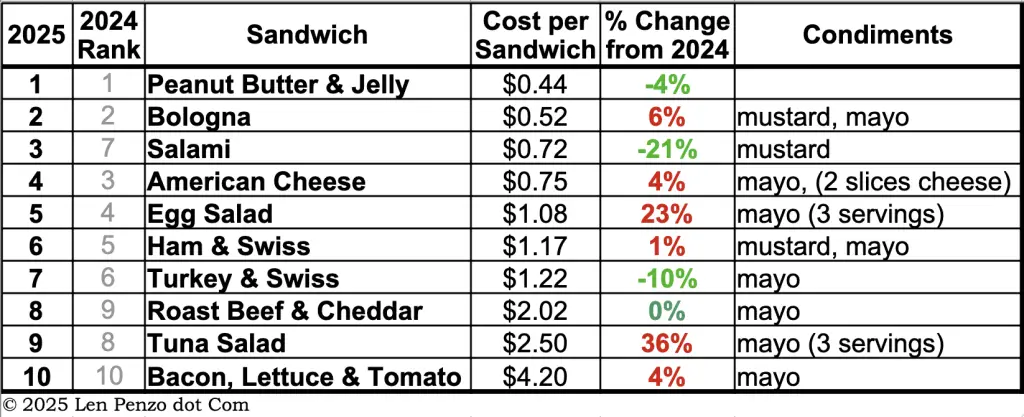
As you can see, at just 44 cents, the unheralded-but-mighty PB&J sandwich remains the undisputed Most Economical Sandwich.
That being said, PB&J’s presence alone at the top of the survey represents a minor upset. That’s because this is only the fourth time in 17 years that bologna has failed to hold at least a share of the Most Economical Sandwich crown.
As for the rest of this year’s rankings, with one big exception, there wasn’t a lot of movement. PB&J and bologna held their positions at the top of the list, as did perennial basement-dweller BLT. Except for Salami, which climbed in the rankings from #7 to #3 – its best survey finish ever – all of the other sandwiches either moved up or down in the standings by one position.
Sandwich Survey Historical Price Data
The next chart is an annual comparison of each sandwich since my inaugural survey in 2009. This year, only the PB&J and salami sandwiches are cheaper than they were in 2024. Even so, the overall effects of food inflation on the surveyed sandwiches are striking.
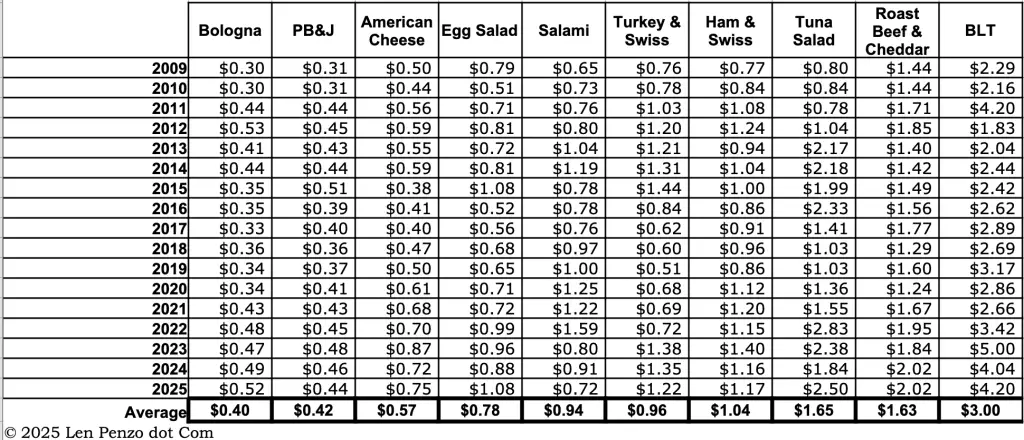
In 2010, the average price of all ten sandwiches was 84 cents – that was the all-time low. This year, the average cost of the survey’s ten sandwiches is $1.46; that’s 5% higher than last year. Even more alarming, this year’s average sandwich price is 30% higher than the 2021 average – and 54% more than it was in 2018. Ouch.
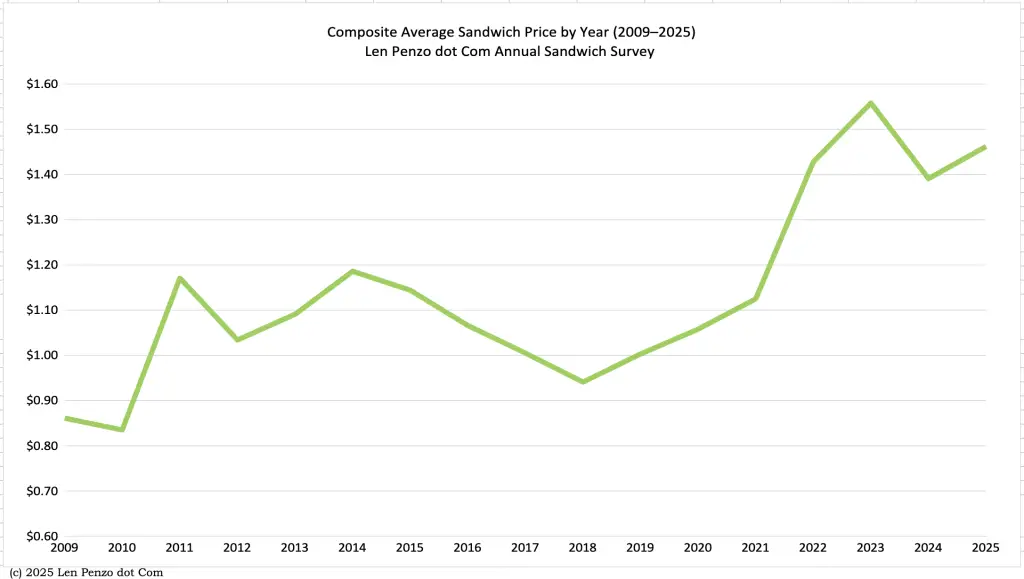
Tips and Observations
- For the first time since 2015, just four sandwiches in this year’s survey cost less than a buck. That’s down from five last year – and seven in 2018.
- The price of bread rose 20% to $1.79. This is after seeing the price of bread fall from its all-time survey high of $1.99 in 2023 to $1.49 last year.
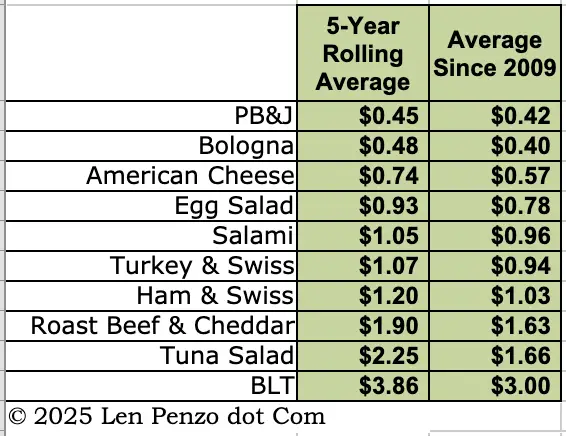 Seven of the 18 sandwich ingredients saw price increases this year: wheat bread, eggs, lettuce, mayo, tuna, bacon, and ham.
Seven of the 18 sandwich ingredients saw price increases this year: wheat bread, eggs, lettuce, mayo, tuna, bacon, and ham.- The price of Swiss cheese more than doubled between 2019 and 2023. The price held steady last year, and declined 8% this year. Compare that to the prices of American and Cheddar, which have remained fairly stable over the same period.
- Are you hooked on tuna? After a massive 97% increase in 2022, albacore tuna prices retreated 90 cents over the following two years. Unfortunately, the surveyed price of albacore tuna is rising again; it’s up 30% from the year before.
- The price of a BLT rose a modest 4% over the past year. The good news is, even at $4.20 this year, a home-cooked BLT is still $2 less than the average price of a Big Mac.
- Cooking your own ham and turkey and slicing it yourself is a great way to reduce your grocery bill. It’s also cheaper to buy block cheese and slice it at home.
- If you’re like me and love to put tomatoes on a sandwich, grow your own— you’ll save a bundle. Best of all, they taste much better than anything you can buy from your grocer.
- You can save upwards of 40% by purchasing store-brand products. As my popular blind taste tests have proven, their quality is often just as good — if not better.
Photo Credit: neil russo

Tip to share.
I am one of those guys who always always packed a lunch and thermos. Co workers would hit the cafe and I just couldn’t afford it because I had a strict savings plan, and in later years it was mortgage and children. Anyway.
Cheaper than all of the above is is not buying specific luncheon meats, rather, using cold cuts off a family roast or other left overs. Ham is the best savings and the Costco hams taste awesome and have no bone…little fat. Costco cheese is also a fraction of supermarket stuff and there are top notch brands. In the winter, don’t even think about using tasteless tomatoes and overpriced lettuce. Instead, grow sprouts on the kitchen counter.
We are lucky that I catch scads of salmon for both canned, smoking, and baking. Leftover salmon makes the best spreads, ever. We also have greenhouses, gardens, etc. But there are other ways to save money for anyone who does not have their own food source and a good way is to just experiment and be aware. Some folks have a micro wave available at work to nuke leftovers. Jobsite folks like myself carry a lunchbox. When I used to fly for a living I ate in the cockpit. If I took a break it would just cost me money, anyway. There is always time when you have to stop and can coffee up while waiting. I know a logging truck driver whose wife bought him a plug-in cooker for his truck. He had great leftovers cooking while he was driving and ate while they unloaded him at the sort.
As an aside, I returned to uni in my late thirties. I was amazed at the younger students buying food in the caff. Every bloody day. Or, buying an overpriced coffee and muffin. My son in law bought a doughnut and coffee everyday on the way to work while he was doing his summer job. I did a quick calculation for him and pointed out the thousands of dollars he was wasting while going to school. (In a nice way) He just never though about it. He will retire at 55 well fixed so it must have made an impression. 🙂
Lunch is fuel. Save the treat meals for an occasion to enjoy, imho.
I rarely bought lunch when I was working. I tried to take my lunch as often as I could. Thankfully, on the days when I did have to buy, our company cafeteria had very reasonable prices.
75 slices of salami for $7.99? That’s a great deal!
Yep. It was a fantastic deal, Tim. This is the high-quality dry salami, not the cheap spiced bologna masquerading as salami.
First of all, I come here annually just for this survey – I’m totally in love with the concept. However, maybe I’m not “mathing” right… None of the ingredients reduced by more than the salami at 29%, yet the salami sandwich reduced by 45%? Isn’t that impossible? Since it’s balanced out by the increase in bread, it should have still increased, but much lower than even the 29%. The Ham and Swiss sandwich components seem a little off as well. The 16th annual link doesn’t appear to be active anymore for me to check (overwritten by the 17th annual when selecting the link). The sandwich crowd demands accountability!
(I assume there’s a formula error and the raw ingredient salami actually decreased by much more)
Hi, Rick. Where would I be without my eagle-eyed readers?
You’re not going crazy. It took me a several minutes to run the issue to ground. There was indeed an error – but it was a data entry error, not a spreadsheet formula error. I entered the wrong 2024 sandwich prices for Salami, Ham & Swiss, and Turkey & Swiss. In essence, I swapped T&S for salami, salami for H&S, and H&S for T&S; of course, that screwed up the 2025 percentage-change results for those three sandwiches. The corrected data is posted.
Great catch!